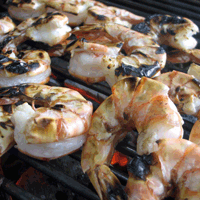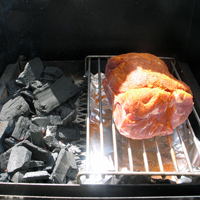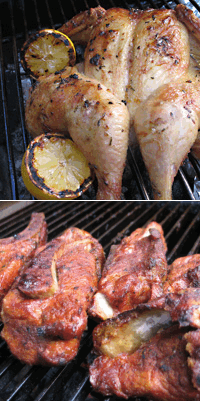|
Here is more specific information, opinion and barbecue lore broken down by
categories of food:

Shrimp grilled in the shell. Do it
this way if you want to use them
in a salad, or you just enjoy getting
a little messy when you eat.

The B1 grill set up for a true
barbecue classic—pork
shoulder.
You can get this one perfect on
our grill and have pulled pork
sandwiches all week.
|
Techniques for mastering the
grill
Grilling looks fairly easy, but there are many variables
and much to learn. In some parts of the world, grilling is a chef's specialty that requires a
lifetime to master, and is highly sought out in the restaurant business. You should taste perfectly
grilled foods once in your life. It's not an accident. To be honest, after grilling for
many years and watching friends and so-called experts ruin expensive food, my current theory
is that, for most of us, if something turns out perfectly, it's sheer luck.
So let's get a basic understanding of what
this is all about.
Foods prepared on the charcoal grill are made
using three basic techniques. (1) Grilling, (2) barbecueing and (3) smoking. But you'll find
different terms to describe the equipment and the techniques depending on what part
of the world you grew up in.
For instance, in Texas a
"grill" is a big stainless steel starship control panel used to burn meat over
a gas flame; a "barbecue" is a black metal sphere used to hang meat over
charcoal until it's too dry to eat.
We're kidding, of course. Texas has some of the
best food, equipment and grill chefs on the planet. They just grew up using their own terms for
what they do.
In other parts of the US "a barbecue" is a
get-together where everybody enjoys smokey, tender meats and traditional side dishes. You
don't cook on a barbecue, you eat barbecue (while attending a
... barbecue). True southern Barbecue can only be made from one of the sacred four: (1) pork
ribs, (2) pork shoulder, (3) beef brisket, and (4) chicken. (Chicken is new to the club and can be
rejected if there are no women around.)
There are even judged contests where
the art of barbecue is raised to new levels and people compete up through regional contests to the
world championships. These amazing foods are prepared on a
"pit" which is a generic term for anything from a hole in the ground to a
side-smoker-on-a-trailer-as-big-as-a-tanker-truck.
The process
usually takes all night and the equipment is big, expensive, and ugly. People spend years
figuring out how to win best in show for a particular item like ribs or brisket so everything
is very competitive and secretive. If you don't join a team and learn the secret
handshake, you may never figure out how it's done. But
this food is
far and away better tasting than what you typically get in a
"barbecue" restaurant. (You can get pretty close to competition-quality barbecue on our B1
backyard grill with a little practice and some of the techniques describe in this site. Most competetive barbecuers use a wood fire for smoke and
charcoal for consistent heat. You can use the same techniques on our B1 grill, and you can
get excellent results in far less time.)
The only reason to get into
this discussion is to learn how to make great tasting food.
You can master this art from experts who have been
perfecting it for generations. We can help you cut through the jargon and get to the
eating.
We love grilling, barbecuing, smoking, searing,
charring, caramelizing, browning, crisping, scorching, toasting and generally experimenting
with man's oldest form of cooking. But no matter what you call the equipment or the process, fire
and smoke make things taste good. Most people would rather eat than talk about eating, so, we offer
our simple ground rules and stand back.
Use
charcoal.
You can make the most amazing flavors with a live charcoal fire "seasoned' with the smoke from wood
chunks, vines, spices, and other things we'll tell you about later. Or you can sear
delicate foods like vegetables and seafood with dry heat and no smoke at
all. We've created our equipment to give you solid options and tools to get it
perfect.
Cook everything you can on the
grill.
The timing can
vary from an all night captain's watch to a 30-second sear. Smoke and fire are versatile
flavoring ingredients, if you know how to use them. Whatever you want to experiment with, if
it doesn't fall through the grate, it'll probably taste better cooked over fire. Try
everything you can think of. Our ancestors somehow made it to the top of the food chain.
Enjoy it while it lasts! :-)
Eat, drink and be merry.
Enjoy life eating wonderful foods with your family and friends. (Most barbecue is just varying
degrees of excellent.) Everybody loves the flavors. Our ancestors have been eating food cooked over
a wood fire for thousands of years. It's probably in our DNA. And it's always a good excuse to have
some fun.
Play with fire.
You know you want to.
|
|

New York Strips and Gooey Onions
Salmon steaks
Pizza
|
Grilling
Direct heat ... expensive meat ...
constant attention. You should light a fairly large load of charcoal and spread the
coals evenly under the cooking grate. If you need more grilling surface area, or more concentrated
heat, add another layer of charcoal wherever you need it after you have spread the initial load and
it will quickly light. This gives you a uniform direct heat zone with the heat lever to
control it.
Grilling is for tender meats such as steak,
hamburger (pre-chewed steak), spatchcocked or cut up chicken, shrimp/crab/lobster and the more
sturdy fish filets (salmon, swordfish, etc). You can also grill vegetables, fruits and tofu. And
you set up for grilling in order to toast bread, sear Ahi, flash cook appetizers.
When grilling, you usually don't close the
cover. Grilling is a radiant heat process and convective heat is a minor factor. Most of these
foods are fairly juicy and will dry out and lose their innate flavors if you cook them too long
with the cover closed. They are usually fairly thin (in cross section) so that the inside can heat
up before the outside is burned. In general, to grill something, you heat the grate for deep char
marks, raise the coals to brown, then lower to finish. The high heat sears the outside, giving
intense flavors, and the inside stays tender and retains the juicy, fresh flavor of the
food.
Be careful. The key to the perfect steak (or
any ongoing obsession) is knowing when to stop. When you fire up our grill, you are controlling a
lot of heat and the interior temperature of a steak can rise more than 10 degrees per minute. The
difference between a perfect $30 steak, and shoe leather, is less than three
minutes.
Also, the foods don't get lot of time to absorb
smoke. So if you want an intensely smokey taste, you should add smoke chips at the beginning of the
process. Once the outside is seared, you don't get much additional flavor into the
food.
|
|

Whole chicken
Country ribs
|
Barbecuing
Indirect heat ... cheaper meat ... have
a drink. To barbecue, you want medium-high heat, but not directly under the food; and
you want the cover closed to get smoky, convective cooking. Your grill is engineered for this. Use
less charcoal than grilling or the temperature under the hood will shoot up to 700 degrees when you
close the cover. After the light, leave the coals on the left side and put your food on the right
over a drip pan . (The grill automatically creates a direct cooking zone on the left side of the
grate, where you light the charcoal.)
You usually barbecue meats that have to cook
longer because they are larger and thicker such as chicken, briskets, turkeys and roasts. They
simply have to be on the grill longer in order to cook through. These cuts are also usually
"messier" in that they drip fats and make a mess. Use the slow cook rack and you can get even the
largest turkey into the grill. We always place an aluminum foil drip pan under the food. It fits
nicely into the coal basket, and we also sell a stainless pan that works beautifully if you like to
have everything in its right place. (Radiohead, favorite song.)
|
|

Smoked ribs
Roast turkey
Pork shoulder roast
|
Smoking
Lowest heat ... cheapest meat ... take
a nap. You can "smoke" on the German grill, depending on your definition of
that term. We do not recommend that you try to achieve a true cold smoke, but you can get the
same results as a competition side smoker or pit.
We use a technique where we light one end of
the charcoal and it burns without any attention at a low smoky rate for up to two hours like a
cigar. (For the light, form a "train" of charcoal on the left side of the coal basket. Light one
end.) Then simply open the front door and add wood chips to generate the smoke. (Remember that you
can do this without opening the cover and losing more heat.) You will see a consistent 250° to 300°
for threee hours. Perfect.
You will generate a genuine "smoke ring",
but you can't get the tenderness of true pit barbecue without one additional step. Wrap the meat in
aluminum foil for an hour or more with some liquid inside the package and put them in the oven or
back on the grill. Do this in order to get the meat hot enough (for long enough) to get to the
"melting" point of the collogens. This can only be done using moist heat. The melting point occurs
around 170° F, and it has to stay above 170° for an hour or more without drying
out.
These ribs were
smoked on the B1 grill using apple wood for smoke, lump charcoal, our home-made
rub and a cider mopping sauce. The pink band around the edges is what the pros call a
"smoke ring" which is a ring of color caused by the interaction of smoke, temperature and
correct technique. If it's there, it means the ribs are going to be smokey flavored, that you used
a proper grill, and that you know what you're doing. If it's not there, you're not doing true
BBQ.
This is when you
get meat that is smoky and brown, yet so tender that grandma can take her teeth out. Use this
method for brisket, ribs, cheap roasts, turkeys and hams. Use a foil drip pan and avoid a big mess.
Throw the meat over direct coals for a few minutes after it comes out of the foil to char the crust
and wow your guests.
Broiling.
Broiling is the same as grilling, but the fire
is over the food instead
of under it. Please don't try to broil on the
German grill.


|
